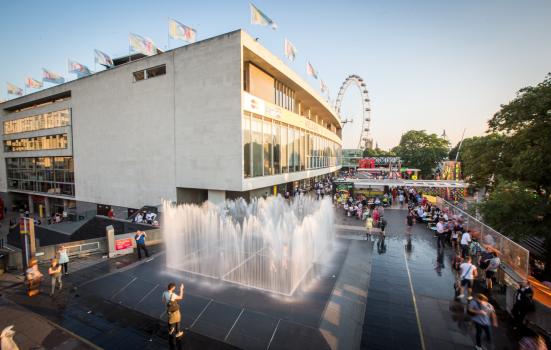London’s South Bank has been an extraordinarily successful regeneration story. Elaine Bedell thinks it’s now time for a new era of regeneration of the arts.

If I stop by the cafe tables at the Royal Festival Hall in the mornings (doors open at 10am every day and anyone can come in) and ask visitors if they know how we’re financed, nine times out of 10 they think it’s publicly funded. Some think by the local authority -Lambeth. Most think it’s funded by the government. But it’s not.
Southbank Centre does receive generous - but declining - public money from Arts Council England (ACE), for which we’re very grateful. But this funding is explicitly for the provision of a year-round artistic programme. It's for the contemporary art we display in the Hayward Gallery and tour around the UK, the huge range of music gigs and concerts we produce, our creative learning work and the hundreds of free events we offer every year.
Like most performing arts institutions, Southbank Centre is responsible for the maintenance and upkeep of its venues. However, we’re also responsible for 11 acres of public realm along the River Thames - the paving stones, the lighting and The Queen’s Walk along which the lying-in-state queue stretched. (And we kept our buildings open all night.)
We don’t receive any funding for the maintenance of this wonderfully popular national heritage site, almost all of it government owned. These site costs – including security, cleaning and heating - now run to £11.5m a year and that’s before the investment needed to keep the buildings fit for purpose and environmentally sustainable.
Culture meets commerce ecosystem
London’s South Bank has been an extraordinarily successful regeneration story. It began with the birth of the Royal Festival Hall during the 1951 Festival of Britain. Its growth along a previously derelict stretch of the river all the way to Tate Modern charted the late Queen’s entire reign.
It has been central in establishing the UK as a global cultural destination. And it was founded from the belief that a war-torn nation needed an imagining of the future through arts and culture available to everyone. Those ideals of inclusiveness and of arts being central to defining a nation are baked into our bricks and mortar and are as important today as ever.
Like many sector colleagues, Southbank Centre has had to be relentlessly entrepreneurial over the years. In 2005, we transformed the business model, creating 14 retail units (restaurants, bars and a bookshop) from largely unused spaces. As a not-for-profit charity, it was this entrepreneurial model that kept us afloat, ushering in a new culture-meets-commerce ecosystem on the South Bank, now being modelled at East Bank.
Financial models need urgent revision
Southbank Centre is the fifth most visited attraction in the UK. Across the site, our footfall is 29m - and those feet create a lot of wear and tear. We’re a tourist destination and a night-time haunt. We support 7,000 jobs and have contributed £530m to Gross Value Added (Hatch Regeneris report 2020). We also carefully invest our annual ACE grant to ensure 35% of everything we present is free. Our artistic work here is wide-ranging and diverse and our audiences reflect this.
From Shakespeare to the Olympics opening ceremony, the performing arts have shaped national events and given voice to our nation’s psyche. Now - in the year of the coronation - is an opportune moment to reflect on what we want our arts institutions to support in this new Carolean era. It’s become increasingly evident to those of us managing large performing arts organisations that traditional financial models need urgent revision.
The gap between Southbank’s earned income and costs - exacerbated by current inflation and tripling energy bills - is getting wider. We’ve proved our success in finding alternative revenue, yet we have almost no spaces left to convert. We’ve been helped by one-off capital grants for refurbishment or restoration - particularly from National Lottery – but improvements made in the noughties are now in urgent need of updating.
We’ve made great progress in sustainability but are in desperate need of funding to convert the infrastructure of our historic buildings to achieve net carbon targets. While grateful for a post-Covid loan from the Cultural Recovery Fund, we now face paying it back with interest, despite a 10% cut in our Arts Council annual grant.
Need for a strategic overhaul
Since 2009, investment in the cultural sector has declined by 21% in real terms - and our ACE funding by 41%. Our ability to generate new revenue with inventiveness is hampered by decaying infrastructure. The result is a vicious circle: it’s more challenging to attract artists and partners to venues that aren’t relevant or sustainable; that means we lose income which in turn means we have less funding to improve the infrastructure.
We’re determined to find ways to maintain the UK’s standing in global arts and culture. But we need help with heritage site and time to plan and achieve better returns. Specifically, we urgently need a clear strategic plan for arts and heritage real estate, building on the legacy and investment of the previous era. Let’s create a new, post-coronation, capital funding committee and strategy for the arts that will keep us innovative and sustainable through the next 30 years.
We also need a longer planning horizon for ACE funding than the current three years. Allowing arts organisations to plan more confidently, supported by more secure, longer-term funding, will result in much better returns for the taxpayer.
We know there are many pressures on the public purse, but large performing arts organisations have proved themselves more than capable of maximising the value of public investment with entrepreneurial zeal. Let’s have a funding strategy for UK arts and culture which allows us to build an innovative and sustainable legacy to suit a new era.
Elaine Bedell is Chief Executive of Southbank Centre.
![]() www.southbankcentre.co.uk/
www.southbankcentre.co.uk/
![]() @southbankcentre
@southbankcentre




